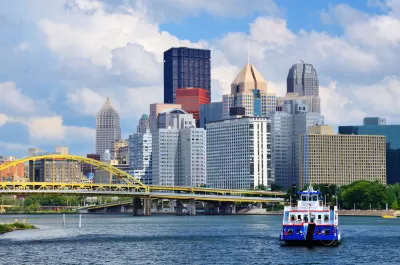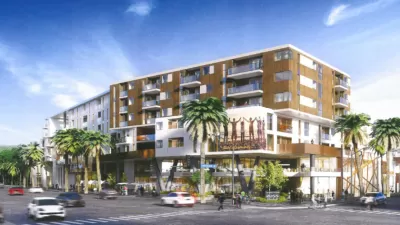The rules are changing, Tom Murphy says, and cities need to change, too.

At the Transit Oriented Los Angeles conference in October, local leaders shared valuable insights drawn from experiences throughout the Southern California region. Tom Murphy—senior fellow with the Urban Land Institute and former mayor of Pittsburgh—offered something different: an outside perspective that synthesized broad trends, observed from work in more than 100 cities.
Murphy urges cities to take advantage of what he calls our "Horatio Nelson Jackson moment," referring to the first person to drive across the United States in an automobile. Cities today stand on the brink of a new economy driven by technological innovation, population growth, and the effects of climate change, he says. To keep pace, they will have to create new tools and forge new ways of doing business.
"The federal government is sort of out to lunch," he says. "State government is largely in the black hole of American politics. That leaves local government to decide whether your community is going to succeed in a world where the fundamental rules are beginning to change."
Since the 1980s, he explains, local government in Pittsburgh has succeeded in transforming "one of the most environmentally degraded and one of the most economically depressed places in America" into one that has been called "the most livable city in America."
The takeaway for Los Angeles—where ballot-box planning has become increasingly common—is that local and regional governments must reinvest in city planning and develop clear, long-term visions for growth and livability.
"I didn’t hear this morning about strategy,” he noted. "What I did hear is that Los Angeles is doing a series of individual transactions without a broader strategy for the kind of community you want to have. This community needs a strategy—a vision. You need to know where you want to go."
FULL STORY: Former Pittsburgh Mayor Opines on LA City’s Lack of Leadership in Planning LA 3.0

Planetizen Federal Action Tracker
A weekly monitor of how Trump’s orders and actions are impacting planners and planning in America.

Restaurant Patios Were a Pandemic Win — Why Were They so Hard to Keep?
Social distancing requirements and changes in travel patterns prompted cities to pilot new uses for street and sidewalk space. Then it got complicated.

Map: Where Senate Republicans Want to Sell Your Public Lands
For public land advocates, the Senate Republicans’ proposal to sell millions of acres of public land in the West is “the biggest fight of their careers.”

Maui's Vacation Rental Debate Turns Ugly
Verbal attacks, misinformation campaigns and fistfights plague a high-stakes debate to convert thousands of vacation rentals into long-term housing.

San Francisco Suspends Traffic Calming Amidst Record Deaths
Citing “a challenging fiscal landscape,” the city will cease the program on the heels of 42 traffic deaths, including 24 pedestrians.

California Homeless Arrests, Citations Spike After Ruling
An investigation reveals that anti-homeless actions increased up to 500% after Grants Pass v. Johnson — even in cities claiming no policy change.
Urban Design for Planners 1: Software Tools
This six-course series explores essential urban design concepts using open source software and equips planners with the tools they need to participate fully in the urban design process.
Planning for Universal Design
Learn the tools for implementing Universal Design in planning regulations.
Heyer Gruel & Associates PA
JM Goldson LLC
Custer County Colorado
City of Camden Redevelopment Agency
City of Astoria
Transportation Research & Education Center (TREC) at Portland State University
Camden Redevelopment Agency
City of Claremont
Municipality of Princeton (NJ)





























